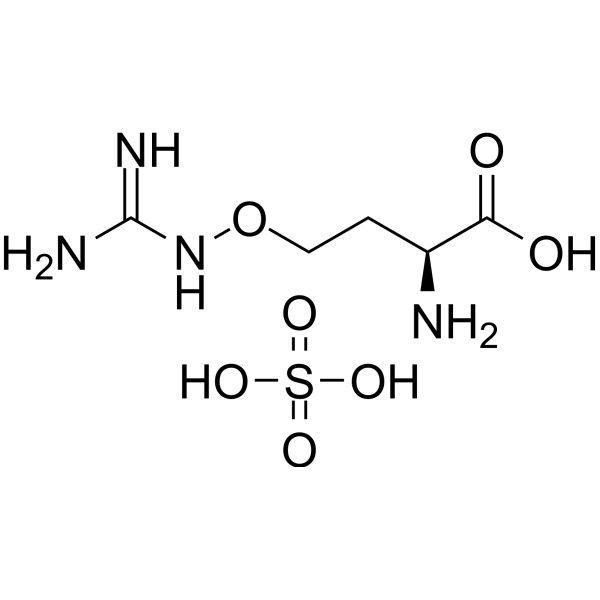Home
Products
L-Canavanine sulfate



| Product Name | L-Canavanine sulfate |
| Price: | Inquiry |
| Catalog No.: | CN00649 |
| CAS No.: | 2219-31-0 |
| Molecular Formula: | C5H14N4O7S |
| Molecular Weight: | 274.2 g/mol |
| Purity: | >=98% |
| Type of Compound: | Alkaloids |
| Physical Desc.: | Powder |
| Source: | The sprouts of Alfalfa. |
| Solvent: | Chloroform, Dichloromethane, Ethyl Acetate, DMSO, Acetone, etc. |
| SMILES: | OS(=O)(=O)O.NC(=N)NOCC[C@@H](C(=O)O)N |
| Contact us | |
|---|---|
| First Name: | |
| Last Name: | |
| E-mail: | |
| Question: | |
| Description | L-Canavanine sulfate is a selective inhibitor of inducible NO synthase. |
| Target | NO synthase[1] |
| In Vitro | L-Canavanine sulfate (L-CAV) causes only a limited degree of cytotoxicity in HeLa, Hep G2, and SK-HEP-1 cells when given alone in arginine-rich media with IC50 values ranging from 5 to 10 mM. In HaCaT keratinocyte cell line, IC50 of L-Canavanine sulfate exceeds the concentration of 10 mM, indicating low cytotoxicity in normal cells in vitro. In arginine-free media, IC50 of L-Canavanine sulfate in HeLa, Hep G2, and SK-HEP-1 cells are 0.21±0.04; 0.64±0.16; and 1.18±0.14 mM, respectively. L-Canavanine sulfate, which is hardly toxic alone, potentiates the cytotoxicity of vinblastine (VIN) and paclitaxel (PTX) in HeLa and hepatocellular carcinoma cells[2]. |
| In Vivo | Administration of L-Canavanine sulfate (100 mg/kg) produces a moderate increase in mean arterial pressure of 20 mm Hg, returns blood pressure to near basal levels and completely attenuates the lipopolysaccharide-induced hypotension. All, but one, endotoxaemic rats dosed with L-Canavanine sulfate (100 mg/kg) survive for 6 h post lipopolysaccharide, after which time the experiment is terminated (n=7)[1]. L-canavanine inhibits DNA synthesis by Li 210 cells in vivo and significantly increases the lifespan of animals bearing the Li 210 leukemia. An optimal dose of 18 g/kg produces a peak increase in lifespan of 44%. The therapeutic dose range is narrow, and a dose of 24 g/kg causes death due to drug toxicity[3]. |
| Cell Assay | A dose-dependent cytotoxicity is examined using the MTT assay. Into each well of 96-well plates, 2×104 of cells are seeded, and after 24 h incubation, cells are incubated with test compounds (including L-Canavanine sulfate). After 24 h, 0.5 mg/mL of MTT is added to each well of HeLa, Caco-2, MIA PaCa-2, BxPC-3 and SK-HEP-1 cells, while MTT is added to Hep G2 after 48 h incubation with test compounds (including L-Canavanine sulfate). The cells are then incubated for 3 h so that the viable cells could produce formazan crystals; they are then dissolved in 100 μL DMSO. After incubation for 10 min in a shaker, the absorption of the formazan is measured at 570 nm using a reader[2]. |
| Animal Admin | Male rats weighing 295 to 305 g are used. After a period of stabilization, 6 mg lipopolysaccharide/kg is administered intravenously in 0.3 mL over 2 min, and cardiovascular parameters are monitored over 5 to 6 h. L-Canavanine sulfate is administered intravenously in a 0.2 mL volume bolus injection at 100 mg/kg[1]. Mice: L-Canavanine is dissolved in phosphate-buffered saline[1]. L-Canavanine (100 mg/mb) is infused at a rate of 0.1 mL/hr through a catheter implanted S.C. over the back. Groups of 5 mice are treated at each dose beveltogether with 6 to 8 control animals and are inspected twice per day for median time of death[1]. |
| Boiling Point | 574ºC at 760mmHg |
| Flash Point | 300.9ºC |
| Exact Mass | 274.058319 |
| PSA | 217.43000 |
| LogP | 0.52230 |
| Vapour Pressure | 1.21E-08mmHg at 25°C |
| Storage condition | 2-8°C |